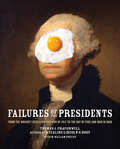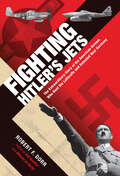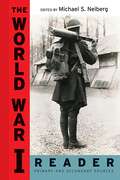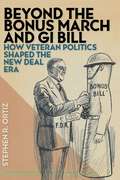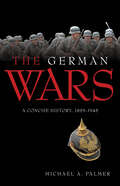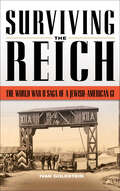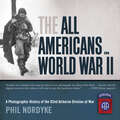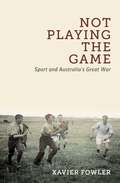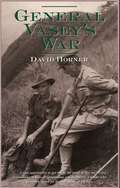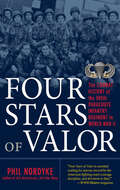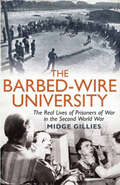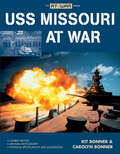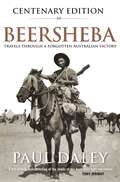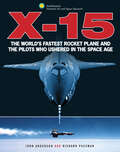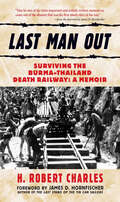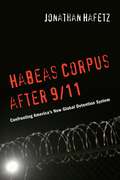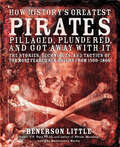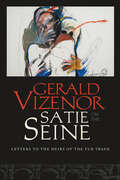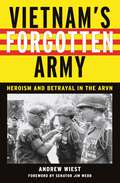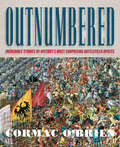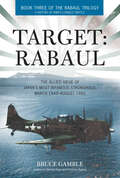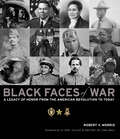- Table View
- List View
Failures of the Presidents: From the Whiskey Rebellion and War of 1812 to the Bay of Pigs and War in Iraq
by M. William Phelps Thomas J. CraughwellTake a humbling journey through America’s proud history with this engaging and informative look at the nation’s most epic presidential blunders.Failures of the Presidents recounts twenty of the worst bad calls to come out of the executive office, ranging from the nation’s birth to the start of the twenty-first century. Author Thomas Craughwell begins with George Washington, who tried to pay for the Revolutionary War with a tax on whiskey—a choice that sparked the newly formed country’s first bloody rebellion.Centuries later, another George—the second President Bush—was convinced that Iraq was hiding weapons of mass destruction. His invasion of the country resulted in a protracted, deadly, and costly war that gave a serious blow to American credibility around the world.Between these episodes, there were many other regrettable, embarrassing, or downright disastrous mistakes made by residents of the White House—the worst of which are explored in this book.
Fighting Hitler's Jets: The Extraordinary Story of the American Airmen Who Beat the Luftwaffe and Defeated Nazi Germany
by Robert F. DorrFighting Hitler's Jets brings together in a single, character-driven narrative two groups of men at war: on one side, American fighter pilots and others who battled the secret “wonder weapons” with which Adolf Hitler hoped to turn the tide; on the other, the German scientists, engineers, and pilots who created and used these machines of war on the cutting edge of technology. Written by Robert F. Dorr, renowned author of Zenith Press titles Hell Hawks!, Mission to Berlin, and Mission to Tokyo, the story begins with a display of high-tech secret weapons arranged for Hitler at a time when Germany still had prospects of winning the war. It concludes with Berlin in rubble and the Allies seeking German technology in order to jumpstart their own jet-powered aviation programs. Along the way, Dorr expertly describes the battles in the sky over the Third Reich that made it possible for the Allies to mount the D-Day invasion and advance toward Berlin. Finally, the book addresses both facts and speculation about German weaponry and leaders, including conspiracy theorists’ view that Hitler escaped in a secret aircraft at the war’s end. Where history and controversy collide with riveting narrative, Fighting Hitler’s Jets furthers a repertoire that comprises some of the United States’ most exceptional military writing.
The World War I Reader
by Michael S. NeibergAn accessible compilation of primary and secondary scholarship on the frequently misunderstood First World WarAlmost 100 years after the Treaty of Versailles was signed, World War I continues to be badly understood and greatly oversimplified. Its enormous impact on the world in terms of international diplomacy and politics, and the ways in which future military engagements would evolve, be fought, and ultimately get resolved have been ignored. With this reader of primary and secondary documents, edited and compiled by Michael S. Neiberg, students, scholars, and war buffs can gain an extensive yet accessible understanding of this conflict. Neiberg introduces the basic problems in the history of World War I, shares the words and experiences of the participants themselves, and, finally, presents some of the most innovative and dynamic current scholarship on the war.Neiberg, a leading historian of World War I, has selected a wide array of primary documents, ranging from government papers to personal diaries, demonstrating the war’s devastating effect on all who experienced it, whether President Woodrow Wilson, an English doughboy in the trenches, or a housewife in Germany. In addition to this material, each chapter in The World War I Reader contains a selection of articles and book chapters written by major scholars of World War I, giving readers perspectives on the war that are both historical and contemporary. Chapters are arranged chronologically and by theme, and address causes, the experiences of soldiers and their leaders, battlefield strategies and conditions, home front issues, diplomacy, and peacemaking. A time-line, maps, suggestions for further reading, and a substantive introduction by Neiberg that lays out the historiography of World War I round out the book.
Beyond the Bonus March and GI Bill: How Veteran Politics Shaped the New Deal Era
by Stephen R. OrtizThe period between World Wars I and II was a time of turbulent political change, with suffragists, labor radicals, demagogues, and other voices clamoring to be heard. One group of activists that has yet to be closely examined by historians is World War I veterans. Mining the papers of the Veterans of Foreign Wars (VFW) and the American Legion (AL), Stephen R. Ortiz reveals that veterans actively organized in the years following the war to claim state benefits (such as pensions and bonuses), and strove to articulate a role for themselves as a distinct political bloc during the New Deal era.Beyond the Bonus March and GI Bill is unique in its treatment of World War I veterans as significant political actors during the interwar period. Ortiz’s study reinterprets the political origins of the "Second" New Deal and Roosevelt’s electoral triumph of 1936, adding depth not only to our understanding of these events and the political climate surrounding them, but to common perceptions of veterans and their organizations. In describing veteran politics and the competitive dynamics between the AL and the VFW, Ortiz details the rise of organized veterans as a powerful interest group in modern American politics.
Kevin Rudd: Twice Prime Minister
by Patrick WellerIt was a very different Kevin Rudd who returned to office in 2013. Kevin 07 was a fresh face and a new image: the convivial, Mandarin-speaking nerd who seemed so different from past leaders and who held so much potential. By 2013 Rudd retained some of his popularity but none of his novelty. The Opposition could say nothing derogatory about him that his colleagues had not already said. A series of policy grenades had to be defused. His second term was to be short, brutal and nasty. Yet, despite his defeat, Kevin Rudd was an unusual Labor leader and prime minister. Political scientist and biographer Patrick Weller spent several years observing and talking to Rudd and the people around him to explain how one person came to the job and sought to meet its demands. Weller takes us back to Rudd's boyhood in Nambour, son of a poor Queensland dairy farmer; to a member without a faction who led a bitterly factionalised party; to the only federal Labor leader to win a majority since Paul Keating in 1993; and to only the second prime minister since 1914 to be sworn in for a second time. This book has the advantage of interviews in 2008 and 2009 with ministers who were then supporters but who became diehard enemies. Weller also had the benefit of unique access to the Prime Minister's Office. His biography is a revealing account of the man who became prime minister - twice.
The German Wars: A Concise History, 1859–1945
by Michael A. Palmer“A fine survey of how a nation came to be recognized for its military supremacy—despite losing two world wars.” —Midwest Book ReviewIn the decades leading up to World War II, the world was in awe of the Prussian-German military, seeking to emulate what esteemed German military history scholar Robert M. Citino has termed “the German Way of War.” Military professionals around the globe became fluent in the tactical jargon: bewegungskrieg, schwerpunckt, auftragstaktik, fingerspitzengefuhl, and of course, blitzkrieg. At the same time, German warfare would become closely associated with the bloodiest and cruelest era in the history of mankind. The German Wars: A Concise History, 1859–1945 outlines the history of European warfare from the Wars of German Unification to the end of World War II. Author Michael A. Palmer looks at political, social, economic, and military developments across Europe and the United States during this crucial period in world history in order to demonstrate the lasting impact of the German Wars on the modern age.“Palmer has succeeded in creating an outstanding short history of the German wars that influenced the development of Europe and the world in the 19th and 20th centuries. It’s a terrific introduction and overview of the subject.” —Armchair General“A provocative look at the methods that Germany used to wage war, and why ultimately they failed.” —Military Heritage“This is an excellent book . . . highly readable. It would be an excellent addition to the library of any military historian, public library, university library as well as personal collection of persons with interest in European or Trans-Atlantic History.” —Kepler’s Military History Book Reviews
Surviving the Reich: The World War II Saga of a Jewish-American GI
by Ivan GoldsteinThe memoirs of a Jewish-American soldier who is taken as a POW by the Germans and survives against all odds.Ivan Goldstein was a nineteen-year-old green-as-grass soldier heading into his first battle: the Battle of the Bulge, World War II’s fiercest engagement between the American army and Hitler’s army. A bow gunner on a Sherman tank, Private Goldstein was only hours into his first battle when his tank was hit by an enemy shell, and he was almost killed. Goldstein escapes with his life . . . only to be captured by the Germans. This could be the story of many young men from what has rightly been called “the Greatest Generation,” but Goldstein is not any young man. He is an American Jew. And when a German officer learns this, the officer says, “In the morning, take the Jew out and shoot him.” What follows is an epic story of survival in the face of seemingly insurmountable odds that is sure to engage everyone interested in the war against the Third Reich.
The All Americans in World War II: A Photographic History of the 82nd Airborne Division at War
by Phil NordykeContaining “close to every photograph ever taken of the 82nd . . . Anyone with the slightest interest in the airborne will want to own this handsome volume” (WWII History magazine).On the night of July 9/10, 1943 the All Americans of the 82nd Airborne Division jumped into history as they made their first parachute assault of World War II. Three others would follow: Salerno, Normandy, and Holland. In total the division served more than three hundred days in combat, a record unmatched by any other American division.With nearly four hundred historic photographs, many never before published, The All Americans in World War II provides a complete photographic history of the 82nd Airborne Division as it fought its way across Sicily, Italy, France, Belgium, and Germany, ultimately all the way to Berlin as part of the American occupation forces. This book is an essential addition to any serious World War II collection and a tribute to the fighting spirit of this legendary division.“Nordyke has assembled a fresh look at the All-Americans that any U.S. WWII enthusiast should consider to be a ‘high priority purchase.’” —Military Trader“A must-own if you are interested in US Airborne operations in Europe . . . great photos, great maps, and great narrative.” —Military History online
Not Playing the Game: Sport and Australia's Great War
by Xavier FowlerWar remembrance and sport have become increasingly entwined in Australia, with AFL and NRL Anzac Day fixtures attracting larger crowds than dawn services. National representative teams travel halfway around the world to visit battle sites etched in military folklore. To validate their integration into this culturally sacred occasion, promoters point to the special role of sport in the development of the Anzac legend, and with it, the birth of the nation. The air of sombre reflection that surrounds each Anzac Day is accompanied by a celebratory nationalism that sport and war supposedly embody. But what exactly is being remembered, and indeed forgotten, in these official commemorations and tributes? In Not Playing the Game, Xavier Fowler reveals that the place of sport in the Great War was highly contested. Civilian patriots and public officials complained that spectator sport distracted young men from enlisting and wasted public finances better spent elsewhere. Sport's defenders argued it was a necessary escape for a population weary of the pressures of war. These competing views often reflected differences of class, politics and ethnicity, and resulted in ferocious, sometimes violent, clashes. Not Playing the Game challenges the way our memories of the war are influenced by the fervour of sport, painting a picture not of triumph but immense turmoil and tragedy.
General Vasey's War
by David HornerTo his troops he was 'Bloody George', a hard-bitten professional soldier, technically competent and tactically proficient. His brigade bore the brunt of the fighting in Greece. He commanded the entire Australian force in Crete in the battle against German airborne invaders. He directed the Australian advance from Kokoda and presided over the defeat of the Japanese in the savage battles of the beachheads. But there was more to Major-General George Vasey than his impressive record. Through the existence of a remarkable collection of letters to his wife, Jessie, we have a rare opportunity to get inside the mind of this successful commander. The picture that emerges is one that his closest comrades knew—one of compassion and humanity, a commander who genuinely cared for the well-being of his men. General Vasey's War analyses Vasey's military performance but it also allows us to share Vasey's private thoughts— his frustrations and triumphs, his hopes and cares. Through a unique insight into one man's war we are rewarded with a better understanding of the practice of warfare during those momentous years.
Four Stars of Valor: The Combat History of the 505th Parachute Infantry Regiment in World War II
by Phil NordykeHailing from the big cities and small towns of America, these young men came together to serve their country and the greater good. They were the 505th Parachute Infantry Regiment of the 82nd Airborne Division (the All Americans). Phil Nordyke, their official historian, draws on interviews with surviving veterans and oral history recordings as well as official archives and unpublished written accounts from more than three hundred veterans of the 505th PIR and their supporting units. This is history as it was lived by the men of the 505th, from their prewar coming of age in the regiment, through the end of World War II, when they marched in the Victory Parade up Fifth Avenue in New York, to the postwar legacy of having been part of an elite parachute regiment with a record unsurpassed in the annals of combat.
The Barbed-Wire University: The Real Lives of Prisoners of War in the Second World War
by Midge Gillies“A moving and eye-opening account of the lives of second world war PoWs by the daughter of a man who was captured . . . a riveting collection of stories.” —The GuardianFeature films like The Bridge on the River Kwai and The Great Escape have created the stereotype of the Second World War prisoner of war. But, as Midge Gillies shows in this groundbreaking work of social history, the true experiences of nearly half a million Allied servicemen held captive during the Second World War were nothing like the Hollywood myth—and infinitely more extraordinary.The real lives of POWs saw them respond to the tedium of a German stalag or the brutality of a Japanese camp with the most amazing ingenuity and creativity. They staged glittering shows, concerts and elaborate sporting fixtures, made exquisite ornaments—even, amid the terrible privations of the Thailand-Burma railway, improvised daring surgical techniques to save their fellow men’s lives. Whatever skills or hobbies they took with them to captivity they managed to continue and adapt—to the extent of laying out a 9-hole golf course between the huts of one German camp. They took up crafts and pastimes using materials they found around them: even the string from a Red Cross food parcel was used to make cricket balls, football nets and wigs for theatrical performances. Men studied, attended lectures, learned languages, sat for qualifications and exams, on such a scale that one camp was nicknamed “The Barbed-Wire University.”Drawing on letters home, diaries and interviews with redoubtable survivors now into their nineties, Midge Gillies recreates the daily lives of a truly remarkable group of men. “Astonishing tales of improvisation, ingenuity and courage.” —The Spectator
USS Missouri at War (The At War Series)
by Kit Bonner Carolyn BonnerAn illustrated history of the wartime career of the USS Missouri from World War II to the Gulf War.On September 2, 1945, surrender ceremonies officially ending World War II were broadcast worldwide from the deck of the USS Missouri. The ceremony also marked the end of one of the most eventful years for any vessel in the history of warfare. USS Missouri at War chronicles the career of this mighty warship, the last battleship built by the United States.Veteran naval historian Kit Bonner describes “Mighty Mo’s” powerful strikes against Japan, its support of the Iwo Jima landings and bombardment of Okinawa, and its decisive role in the destruction of key Japanese industrial targets. That war was over, but the Missouri was not done yet; and Bonner follows her service in the Korean War, her modernization and reactivation for the 1991 Gulf War, and her final decommissioning in 1992, with eleven battle stars to her credit.For its authoritative and close-up look at the life and work of a world-class battleship, and for its insight into the history of twentieth-century naval warfare, this strikingly illustrated book is one that no naval enthusiast or military history buff will want to be without.
Beersheba Centenary Edition: Travels through a forgotten Australian victory
by Paul DaleyA hundred years ago in October 1917 members of the 4th Australian Light Horse Brigade participated in what is now regarded as the last great successful cavalry charge. Waving bayonets overhead in the dying light, they raced across six kilometres of exposed ground in Palestine, surprising the well-entrenched Turks. It was the decisive blow in the British capture of the strategic stronghold of Beersheba. The story of this remarkable military victory has largely slipped through the cracks of history, eclipsed in Australian sentiment by stories of dramatic defeat and loss at Gallipoli and on the Western Front. Paul Daley goes in search of the story of Beersheba. What he uncovers is a story of ordinary men capable of extraordinary acts, as he sheds new light on a dark episode starkly at odds with the Anzac mythology.
X-15: The World's Fastest Rocket Plane and the Pilots Who Ushered in the Space Age (Smithsonian Ser.)
by John Anderson Richard PassmanThe concise illustrated history of the first space plane, featuring exclusive photographs.The exciting story of the X-15—the iconic rocket plane of the Cold War space race is recounted by John Anderson, curator of aerodynamics at the Smithsonian National Air and Space Museum. This experimental space plane was on the cutting edge of hypersonic aerodynamics, and its winged reentry from space foreshadowed the development of the Space Shuttle decades later. Launched from the wing of a modified B-52 bomber—again foretelling a concept that would be used decades later, in this case by SpaceShipOne and SpaceShipTwo—the ship rocketed higher and faster than any manned aircraft of the time. Designed to approach seven times the speed of sound, it was the first hypersonic aircraft ever created and was engineered to function both in the Earth’s atmosphere and at the edge of space. Illustrated with period NASA and USAF photographs, as well as exclusive Smithsonian photography of the first of three X-15s built, X-15 captures the risks and dangers of the X-15 program as Anderson follows the test pilots (including Neil Armstrong) who pushed the very limits of their piloting skills to master groundbreaking experimental technology. Even with the fatal crash of the third X-15, the overall success of the program helped pave the way for NASA to continue to the Moon—and this is the definitive, expertly curated, and beautifully illustrated account of its development.Praise for X-15“[X-15] lays out the case for why the X-15 was and continues to be such an important aircraft. This book makes the reader want to visit the National Air and Space Museum and view the X-15 up-close in a whole new light, in which its aerospace accomplishments rank alongside other distinguished aircraft on display at the museum.” —DefenseMediaNetwork.com“The authors have crafted an excellent introductory story for this aircraft. This book is a good read and I can highly recommend it to anyone who wants to start to learn about this most remarkable airplane.” —International Plastic Modelers Society
Last Man Out: Surviving the Burma-Thailand Death Railway: A Memoir
by H. Robert CharlesAn American Marine recounts his ordeal as a World War II POW forced by the Japanese to build the railway immortalized in The Bridge on the River Kwai.From June 1942 to October 1943, more than 100,000 Allied POWs who had been forced into slave labor by the Japanese died building the infamous Burma-Thailand Death Railway, an undertaking immortalized in the film The Bridge on the River Kwai. One of the few who survived was American Marine H. Robert Charles, who describes the ordeal in vivid and harrowing detail in Last Man Out. The story mixes the unimaginable brutality of the camps with the inspiring courage of the men, such as a Dutch Colonial Army doctor whose skill and knowledge of the medicinal value of wild jungle herbs saved the lives of hundreds of his fellow POWs, including the author.Praise for Last Man Out“A remarkable story, long overdue, of the treatment of POW’s captured by Japan.” —Arthur L. Maher, USN, Senior officer to survive sinking of the USS Houston, POW of the Japanese in World War II“In World War II, to move materials and troops from Japan to Burma by avoiding the perilous sea route around the Malay Peninsula, the Japanese military built a railroad through the jungles of Thailand and Burma at great human cost to its prisoner laborers. Last Man Out is an effective addition to the history of this tragedy.” —Library Journal
Habeas Corpus after 9/11: Confronting America’s New Global Detention System
by Jonathan Hafetz2012 American Bar Association Gavel Award Honorable Mention for Books2012 Scribes Book Silver Medal Award presented by the American Society of Legal WritersThe U.S. detention center at Guantánamo Bay has long been synonymous with torture, secrecy, and the abuse of executive power. It has come to epitomize lawlessness and has sparked protracted legal battles and political debate. For too long, however, Guantánamo has been viewed in isolation and has overshadowed a larger, interconnected global detention system that includes other military prisons such as Bagram Air Base in Afghanistan, secret CIA jails, and the transfer of prisoners to other countries for torture. Guantánamo is simply—and alarmingly—the most visible example of a much larger prison system designed to operate outside the law.Habeas Corpus after 9/11 examines the rise of the U.S.-run global detention system that emerged after 9/11 and the efforts to challenge it through habeas corpus (a petition to appear in court to claim unlawful imprisonment). Habeas expert and litigator Jonathan Hafetz gives us an insider’s view of the detention of “enemy combatants” and an accessible explanation of the complex forces that keep these systems running. In the age of terrorism, some argue that habeas corpus is impractical and unwise. Hafetz advocates that it remains the single most important check against arbitrary and unlawful detention, torture, and the abuse of executive power.
How History's Greatest Pirates Pillaged, Plundered, and Got Away With It: The Stories, Techniques, and Tactics of the Most Feared Sea Rovers from 1500–1800
by Benerson LittleWho were the world’s most successful pirates, and why? “Interesting and very readable . . . Little clearly knows his subject well.” —International Journal of Naval HistoryMore than just simple retellings of tried-and-true stories of buccaneers on the high seas, this book focuses on pirating tactics of the 1500s through the 1800s to give an in-depth view of how pirates functioned through history. Stories of the thirteen most famous pirates as they raid major ships and pillage coastal villages reveal how the pirates approached such invasions—and how they managed to elude authorities and sometimes whole navies. In addition, vivid firsthand descriptions recreate the excitement, fear, and fury of the most famous raids by these outlaws of the ocean. Delving deep to show piracy’s profound impact on trade, politics, military strategy, culture, and individual lives, the book sifts truth from myth, carefully reconstructs the geopolitical context of each story, and analyzes the tactics that brought the pirates glory, or led to their downfall. Also included are archival images gathered from around the world by the author, a former Navy SEAL and consultant on maritime security.
Satie on the Seine: Letters to the Heirs of the Fur Trade
by Gerald VizenorIn this historical epistolary novel from an award-winning author, Native American brothers survive the Nazi occupation of Paris. In this powerful epistolary novel, acclaimed Anishinaabe author Gerald Vizenor interweaves history, cultural stories, and irony to reveal a shadow play of truth and politics. Basile Hudon Beaulieu lives in a houseboat on the River Seine in Paris between 1932 and 1945. He observes the liberals, fascists, artists, and bohemians, and presents puppet shows. His thoughts and experiences are documented in the form of fifty letters to the heirs of the fur trade. Basile comments on the mercy of liberté, the torment and solidarity of Le Front Populaire and the alliance of political leftists, and considers at the same time the massacres of Native Americans, and the misery of federal policies on reservations in relation to the savage strategies of royalists, fascists, communists, and anti-Semites. The hand puppets created by Basile and his brother Aloysius make brilliant commentaries of their own, and the letters include accounts of parleys between the puppet versions of Gertrude Stein and Adolf Hitler, Apollinaire and Anaïs Nin, Sitting Bull and Victor Hugo, Carlos Montezuma and Émile Zola, Chief Joseph and Voltaire, and others. Vizenor is a unique voice of Native American presence in the world of literature, and in his inimitable creative style he delivers a moving, challenging, and darkly humorous commentary on war and modernity.
Fighting to Leave: The Final Years of America's War in Vietnam, 1972–1973
by Colonel Robert E. StoffeyFrom a Vietnam wartime veteran and US Marine officer, an insider’s account of the final military strategies of the Vietnam war.Perhaps more vexing than any part of the Vietnam War—Americas longest—was getting out. This book offers a chronicle of those last difficult years, 1972 and 1973, that is at once a detailed and thorough overview and at the same time a vividly personal account. The year 1972 found Marine Corps pilot Robert E. Stoffey beginning his third combat tour in Vietnam.After flying 440 combat missions out of Da Nang and Marble Mountain Airfields in South Vietnam—and being shot down twice—between 1965 and 1970, Stoffey was in a unique position to judge the United States changed strategy. From the vantage point of the USS Oklahoma City, he fought—and observed—the critical and complex last two years of the war as Marine Air Officer and Assistant Amphibious Warfare Officer on the staff of the Commander, Seventh Fleet. As the South Vietnamese battled for survival against the onslaught from the Communist North Vietnamese Army, the US Seventh Fleet, afloat in the Gulf of Tonkin and the South China Sea, was a significant supporting force.With the US Navy’s mining of North Vietnams waterways, concentrated shore bombardments, and air attacks, this sea power was instrumental in leading to the negotiated end of the war and return of our POWs. This is the story that Robert Stoffey tells in his firsthand account of how the Vietnam War finally ended and what it took to get our POWs home.
The Americans on D-Day: A Photographic History of the Normandy Invasion
by Martin K. MorganExperience the Normandy invasion through some of D-Day’s most incredible photographs: “A rare contribution to our understanding of that historic event.” —Barrett Tillman, author of Brassey’s D-Day EncyclopediaAlthough it took a multinational coalition to conduct World War II’s amphibious D-Day landings, the US military made a major contribution to the operation that created mighty American legends and unforgettable heroes. In The Americans on D-Day: A Photographic History of the Normandy Invasion, WWII historian Martin K. A. Morgan presents 450 of the most compelling and dramatic photographs captured in northern France during the first day and week of its liberation.With eight chapters of place-setting author introductions, riveting period imagery, and highly detailed explanatory captions, Morgan offers anyone interested in D-Day a fresh look at a campaign that was fought many decades ago and yet remains the object of unwavering interest to this day. While some of these images are familiar, they have been treated anonymously for far too long and haven’t been placed within the proper context of time or place. Many others have never been published before. Together, these photographs reveal minute details about weapons, uniforms, and equipment, while simultaneously narrating an intimate human story of triumph, tragedy, and sacrifice. From Omaha Beach to Utah, from Sainte-Mère-Église to Pointe du Hoc, The Americans on D-Day is a striking visual record of the epic air, sea, and land battle that was the Normandy invasion.
Vietnam's Forgotten Army: Heroism and Betrayal in the ARVN
by Andrew Wiest2009 Society for Military History Distinguished Book Award for BiographyExamines South Vietnam’s complex relationship with the United States through the stories of two Vietnamese soldiers' diverging pathsVietnam’s Forgotten Army: Heroism and Betrayal in the ARVN chronicles the lives of Pham Van Dinh and Tran Ngoc Hue, two of the brightest young stars in the Army of the Republic of Vietnam (ARVN). Both men fought with valor in a war that seemed to have no end, exemplifying ARVN bravery and determination that is largely forgotten or ignored in the West. However, while Hue fought until he was captured by the North Vietnamese Army and then endured thirteen years of captivity, Dinh surrendered and defected to the enemy, for whom he served as a teacher in the reeducation of his former ARVN comrades. An understanding of how two lives that were so similar diverged so dramatically provides a lens through which to understand the ARVN and South Vietnam’s complex relationship with America's government and military. The lives of Dinh and Hue reflect the ARVNs battlefield successes, from the recapture of the Citadel in Hue City in the Tet Offensive of 1968, to Dinhs unheralded role in the seizure of Hamburger Hill a year later. However, their careers expose an ARVN that was over-politicized, tactically flawed, and dependent on American logistical and firepower support. Marginalized within an American war, ARVN faced a grim fate as U.S. forces began to exit the conflict. As the structure of the ARVN/U.S. alliance unraveled, Dinh and Hue were left alone to make the most difficult decisions of their lives. Andrew Wiest weaves historical analysis with a compelling narrative, culled from extensive interviews with Dinh, Hue, and other key figures. Once both military superstars, Dinh is viewed by a traitor by many within the South Vietnamese community, while Hue, an expatriate living in northern Virginia, is seen as a hero who never let go of his ideals. Their experiences and legacies mirror that of the ARVNs rise and fall as well as the tragic history of South Vietnam.
Outnumbered: Incredible Stories of History's Most Surprising Battlefield Upsets
by Cormac O'BrienFourteen dramatic stories of troops outnumbered but not outmatched—from Hannibal’s Carthaginians to the English at Agincourt to the Red Army in WWII.Even a commander as fearless, self-assured, and battle-hardened as Alexander the Great, leading 40,000 Macedonian troops, must have quailed at the sight that met him as he neared the village of Issus, Asia Minor, in 333 BCE: an unexpectedly and unimaginably vast Persian force of some 100,000 men, spanning the Mediterranean coastal plain as far as the eye could see. For warfare had already demonstrated, and has confirmed ever since, that numerical superiority consistently carries the day. And yet, every once in a while, such lopsided engagements have had an unexpected outcome, and proved to be a crucible in which great leaders, and history, are forged.Outnumbered chronicles fourteen momentous occasions on which a smaller, ostensibly weaker force prevailed in an epochal confrontation. Thus, Alexander, undaunted, devised a brilliant and daring plan that disoriented and destroyed the Persian force and, consequently, its empire. Likewise, during the US Civil War, Confederate Gen. Robert E. Lee, despite being out-positioned and outnumbered more than two to one by Union forces at Chancellorsville, Virginia, hatched an audacious and surprise strategy that caught his enemy completely unawares. Other equally unexpected, era-defining victories are shown to have derived from the devastating deployment of unusual weaponry, sheer good fortune, or even the gullibility of an enemy, as when Yamashita Tomoyuki, commander of 35,000 ill-supplied Japanese troops, convinced the 85,000-strong British Commonwealth army to surrender Singapore in 1942.Together these accounts constitute an enthralling survey that captures the excitement and terrors of battle, while highlighting the unpredictable nature of warfare and the courage and ingenuity of inspired, and inspiring, military leaders who, even when the odds seemed insurmountable, found a path to glory.“There are similar titles about decisive battles and interesting campaigns, but none quite like this . . . an appealing choice for many military history enthusiasts.” —Library JournalIncludes color illustrations and maps
Target: The Allied Siege of Japan's Most Infamous Stronghold, March 1943–August 1945 (The Rabaul Trilogy)
by Bruce GambleA history of World War II’s Operation Cartwheel, a major Allied operation by US, Australian, and New Zealand forces to take the Japanese base at Rabaul.Prior to World War II, few Americans had heard of Rabaul, a small harbor town in a far-off corner of the Pacific. But it became a household name after the Japanese captured Rabaul in January 1942 and developed it into their most heavily defended fortress outside the home islands. Thereafter, Rabaul endured Allied air attacks for a total of forty-four months—a span unmatched by any other locale during World War II.In Target: Rabaul, respected military historian Bruce Gamble concludes his critically acclaimed trilogy about Japan’s most notorious stronghold. Picking up where Fortress Rabaul left off, Gamble narrates the story of Cartwheel, the multiple-operation plan that isolated Rabaul through aerial and naval siege. The effort, involving all of the armed branches of the United States, Australia, and New Zealand, resulted in some of the heaviest and most dramatic aerial combat of the Pacific war, with frequent clashes between hundreds of planes.The culmination of an amazing story, Target: Rabaul profiles the resolve of the Allied and Japanese combatants in the horrific Pacific battleground—and provides the turbulent, triumphant conclusion to the most comprehensive account of World War II’s longest battle.“Bruce Gamble has done it again! An impeccable researcher and a master storyteller with a keen eye for details and characters, Gamble presents Target: Rabaul, a powerful conclusion to his must-read trilogy on the battle over Japan’s Southwest Pacific stronghold. The heart-pounding stories of aerial combat read like a thriller—and show why he is one of the finest writers working today.” —James Scott, author of The War Below and The Attack on the Liberty
Black Faces of War: A Legacy of Honor from the American Revolution to Today
by Robert V. MorrisThis commemoration of African-Americans in the U.S. military includes contributions from W. Stephen Morris and Luther H. Smith, one of the most-celebrated Tuskegee Airmen. Other black military heroes featured in the book include Crispus Attucks, the first man to die in the Revolutionary War; Lt. James Reese Europe, who brought jazz music to Europe in 1918; Lt. Charity Adams, commander of the only all-black Women's Army Corps unit during World War II; and Gen. Colin Powell, who served with distinction in Vietnam, became the first African-American Chairman of the Joint Chiefs of Staff during the Gulf War, and retired a four-star general before becoming the first African-American Secretary of State.
